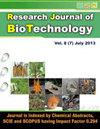响应面方法优化提高非洲罂粟荚中根瘤菌的乳酸产量
IF 0.2
Q4 Biochemistry, Genetics and Molecular Biology
引用次数: 0
摘要
通过微生物发酵将木质纤维素生物质转化为乳酸(LA)受到了广泛关注,因为它可以确保废物的价值化,并减少对化石资源的依赖。首先,测定了非洲罂粟豆荚(PAP)的近似物和植物化学成分。然后,按照全因子设计,使用稀酸水解法对之前经过生物预处理的非洲原麻荚果进行糖化。优化因素包括酸类型(盐酸和 H2SO4)、酸浓度(1%、3% 和 5%)、固体负载率(5%、10% 和 20%)和反应时间(15、30 和 60 分钟)。对几种根瘤菌(Rhizopus oryzae)分离物进行了生产 LA 的筛选,并对其中产量最高的分离物进行了分子鉴定。采用半因子设计筛选了影响 PAP 水解产物 LA 产量的因素。然后采用箱-贝肯响应面设计法(RSM)对重要因素进行优化。近似分析表明,蛋白质、脂肪、灰分和碳水化合物的含量较高。PAP 的植物化学分析显示存在黄酮类、生物碱、皂甙、酚类、单宁、苷类和萜类化合物。在盐酸浓度为 3%、固体含量为 20%、水解时间为 15 分钟的水解条件下,产生的还原糖最高,为 42.5 克/升。最有前途的分离株被鉴定为 R. oryzae 菌株 AK-22,在 RSM 优化后产量为 19.7 克/升,比非优化条件下的产量提高了 38.1%。这些发现是关于从非洲罂粟的荚果中生物技术生产 LA 的。本文章由计算机程序翻译,如有差异,请以英文原文为准。
Response surface methodology optimisation enhancing lactic acid production from Prosopis africana pods by Rhizopus oryzae
Microbial fermentation of lignocellulosic biomass into lactic acid (LA) has received considerable attention because it ensures the valorisation of wastes and reduces dependence on fossil sources. First, the proximate and phytochemical compositions of Prosopis africana pods (PAP) were determined. Previous biologically-pretreated pods of Prosopis africana were then saccharified using dilute acid hydrolysis following a full factorial design. The factors optimized were acid type (HCl and H2SO4), acid concentration (1 %, 3 % and 5 %), solid loading ratio (5 %, 10 % and 20 %) and reaction time (15, 30 and 60 minutes). Several Rhizopus oryzae isolates were screened for LA production and the most prolific was molecularly identified. The factors affecting LA yield from PAP hydrolysate were screened using a half-factorial design. The significant factors were then optimised using Box-Behnken Design of Response Surface Methodology (RSM). The proximate analysis showed high levels of protein, lipid, ash and carbohydrates. The phytochemical analysis of PAP revealed the presence of flavonoids, alkaloids, saponins, phenols, tannins, glycosides and terpenoids. The hydrolysis conditions of 3 % HCl, 20 % solid loading and 15 minutes hydrolysis time yielded the highest reducing sugars of 42.5 g/L. The most promising isolate, identified as R. oryzae strain AK-22, produced 19.7 g/L after RSM optimization, a 38.1 % increase over yields from non-optimised conditions. These findings are on the biotechnological production of LA from the pods of Prosopis africana, an abundant yet under-utilised tree crop.
求助全文
通过发布文献求助,成功后即可免费获取论文全文。
去求助
来源期刊

Research Journal of Biotechnology
工程技术-生物工程与应用微生物
CiteScore
0.60
自引率
0.00%
发文量
192
审稿时长
1.5 months
期刊介绍:
We invite you to contribute Research Papers / Short Communications / Review Papers:
-In any field of Biotechnology, Biochemistry, Microbiology and Industrial Microbiology, Soil Technology, Agriculture Biotechnology.
-in any field related to Food Biotechnology, Nutrition Biotechnology, Genetic Engineering and Commercial Biotechnology.
-in any field of Biotechnology related to Drugs and Pharmaceutical products for human beings, animals and plants.
-in any field related to Environmental Biotechnolgy, Waste Treatment of Liquids, Soilds and Gases; Sustainability.
-in inter-realted field of Chemical Sciences, Biological Sciences, Environmental Sciences and Life Sciences.
-in any field related to Biotechnological Engineering, Industrial Biotechnology and Instrumentation.
-in any field related to Nano-technology.
-in any field related to Plant Biotechnology.
 求助内容:
求助内容: 应助结果提醒方式:
应助结果提醒方式:


